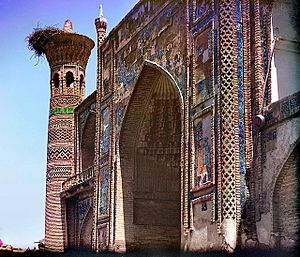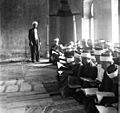Madrasa facts for kids

A madrasa (which comes from the Arabic word madrasa) is a type of school or college. It's a place where people go to learn, and it can teach about many different subjects. Sometimes, madrasas focus on religious studies, especially Islamic ones. But they can also teach about other things like science, math, and language.
The word "madrasa" is used in many countries and can be spelled in different ways, like madrasah, medresa, or madrassa. These schools have been important centers of learning for hundreds of years, especially in the Islamic world.
Contents
What is a Madrasa?
A madrasa is basically a school. In Arabic, the word simply means "a place of study." For a long time, madrasas were the main places for higher education in many parts of the world. They were often built near mosques, which are Islamic places of worship.
These schools taught a wide range of subjects. While religious studies like the Qur'an (the holy book of Islam) and Islamic law were central, students also learned about:
- Arabic language and grammar
- Logic and philosophy
- Mathematics and astronomy
- Medicine and other sciences
Many madrasas also provided a place for students to live, like a dormitory. This allowed students from far away to come and study.
History of Madrasas
Madrasas have a very long history. Some of the earliest ones appeared around the 9th and 10th centuries. They became very common during the Abbasid Caliphate, a large Islamic empire.
One of the most famous early madrasas was the University of al-Qarawiyyin in Fes, Morocco. It was founded in 859 AD and is often considered one of the oldest universities in the world. Another important one was the Mustansiriya Madrasah in Baghdad, which opened in 1227.
During the Middle Ages, madrasas played a huge role in spreading knowledge. They helped to preserve and advance learning in many fields. Scholars from madrasas made important discoveries in science, medicine, and mathematics.
How Madrasas Worked
Madrasas were usually supported by wealthy people or rulers. These patrons would provide money to build the school and pay the teachers. They often included a mosque, a library, and rooms for students.
Students would typically start their education at a young age. They would learn basic subjects before moving on to more advanced studies at a madrasa. Teachers, called ulama (scholars), would guide the students through their learning.
Learning often involved memorizing texts and discussing ideas. Students would sit in circles around their teachers. They would debate and ask questions to deepen their understanding. When a student finished their studies, they would receive a certificate. This certificate showed they were qualified in certain subjects.
Madrasas Today
Today, madrasas still exist in many parts of the world. Some continue to focus mainly on religious education. Others have updated their teaching to include modern subjects alongside traditional ones.
In some countries, madrasas are part of the national education system. In others, they are private schools. They continue to be important cultural and educational centers in many communities.
Images for kids
-
The three madrasas at the Registan of Samarkand, at the center of the Timurid Renaissance
-
View of the Qarawiyyin Mosque (marked by the green roofs and the white minaret) on the skyline of historic Fes
-
Courtyard of the Al-Azhar Mosque and University in Cairo, Egypt
-
Bosnian Madrasa, c. 1906
-
Al-Azhar Mosque and University in Cairo
-
Ince Minaret Medrese (13th century) in Konya, now housing the Museum of Stone and Wood Art
-
Courtyard of the Ben Youssef Madrasa (16th century) in Marrakesh
-
Courtyard of the Ulugh Beg Madrasa (15th century) in Samarkand
-
The Salis Medrese, part of the Süleymaniye complex (16th century) in Istanbul
-
Şemsi Pasha Mosque and medrese (1580) in Üsküdar, Istanbul
-
Courtyard of the Bou Inania Madrasa in Fes
-
Alauddin Khalji's Madrasa, Qutb complex, built in the early-14th century in Delhi, India.
-
Madrasa in Bangladesh
-
This is a madarasa of the Jamia Masjid mosque in Srirangapatna, India. This mosque dates back to the 1700s and is where Tipu Sultan used to pray.
-
Students of Madrasah Aljunied Al-Islamiah in Singapore
-
A Muslim kindergarten in Yangzhou, China
See also
 In Spanish: Madrasa para niños
In Spanish: Madrasa para niños





















